I have problems with deserializing/serializing some xsd schemas, specially with substitution group elements (substitutiongroup) within. What I want to do is to generate C# classes from xsd schemas, then handle with object and later serialize them into a valid XML format. There are 4 xsd files which I deserialize and serialize with xsd2code or xsd.exe. Both tools generate similar unsatisfactory results. They ignore "substitutiongroup" elements and don't generate class members properly. When i run xsd.exe or xsd2code the generated c# class for BPMNPlane for example don't contain a member BPMNShape(however BPMNDiagram class contain BPMNPlane). I tried to change the generated C# classes( e.g . add members/properties), but the generated XML output wasn't correct. I suppose one could master this with linq-to-xml, but they are too much different elements, approximately 70, with additional properties attributes.
<xsd:import namespace="http://www.omg.org/spec/DD/20100524/DC" schemaLocation="DC.xsd" />
<xsd:import namespace="http://www.omg.org/spec/DD/20100524/DI" schemaLocation="DI.xsd" />
<xsd:element name="BPMNDiagram" type="bpmndi:BPMNDiagram" />
<xsd:element name="BPMNPlane" type="bpmndi:BPMNPlane" />
<xsd:element name="BPMNLabelStyle" type="bpmndi:BPMNLabelStyle" />
<xsd:element name="BPMNShape" type="bpmndi:BPMNShape" substitutionGroup="di:DiagramElement" />
<xsd:element name="BPMNLabel" type="bpmndi:BPMNLabel" />
<xsd:element name="BPMNEdge" type="bpmndi:BPMNEdge" substitutionGroup="di:DiagramElement" />
<xsd:complexType name="BPMNDiagram">
<xsd:complexContent>
<xsd:extension base="di:Diagram">
<xsd:sequence>
<xsd:element ref="bpmndi:BPMNPlane" />
<xsd:element ref="bpmndi:BPMNLabelStyle" maxOccurs="unbounded" minOccurs="0" />
</xsd:sequence>
</xsd:extension>
</xsd:complexContent>
</xsd:complexType>
<xsd:complexType name="BPMNPlane">
<xsd:complexContent>
<xsd:extension base="di:Plane">
<xsd:attribute name="bpmnElement" type="xsd:QName" />
</xsd:extension>
</xsd:complexContent>
</xsd:complexType>
<xsd:complexType name="BPMNEdge">
<xsd:complexContent>
<xsd:extension base="di:LabeledEdge">
<xsd:sequence>
<xsd:element ref="bpmndi:BPMNLabel" minOccurs="0" />
</xsd:sequence>
<xsd:attribute name="bpmnElement" type="xsd:QName" />
<xsd:attribute name="sourceElement" type="xsd:QName" />
<xsd:attribute name="targetElement" type="xsd:QName" />
<xsd:attribute name="messageVisibleKind" type="bpmndi:MessageVisibleKind" />
</xsd:extension>
</xsd:complexContent>
</xsd:complexType>
<xsd:complexType name="BPMNShape">
<xsd:complexContent>
<xsd:extension base="di:LabeledShape">
<xsd:sequence>
<xsd:element ref="bpmndi:BPMNLabel" minOccurs="0" />
</xsd:sequence>
<xsd:attribute name="bpmnElement" type="xsd:QName" />
<xsd:attribute name="isHorizontal" type="xsd:boolean" />
<xsd:attribute name="isExpanded" type="xsd:boolean" />
<xsd:attribute name="isMarkerVisible" type="xsd:boolean" />
<xsd:attribute name="isMessageVisible" type="xsd:boolean" />
<xsd:attribute name="participantBandKind" type="bpmndi:ParticipantBandKind" />
<xsd:attribute name="choreographyActivityShape" type="xsd:QName"/>
</xsd:extension>
</xsd:complexContent>
</xsd:complexType>
<xsd:complexType name="BPMNLabel">
<xsd:complexContent>
<xsd:extension base="di:Label">
<xsd:attribute name="labelStyle" type="xsd:QName" />
</xsd:extension>
</xsd:complexContent>
</xsd:complexType>
<xsd:complexType name="BPMNLabelStyle">
<xsd:complexContent>
<xsd:extension base="di:Style">
<xsd:sequence>
<xsd:element ref="dc:Font" />
</xsd:sequence>
</xsd:extension>
</xsd:complexContent>
</xsd:complexType>
<xsd:simpleType name="ParticipantBandKind">
<xsd:restriction base="xsd:string">
<xsd:enumeration value="top_initiating" />
<xsd:enumeration value="middle_initiating" />
<xsd:enumeration value="bottom_initiating" />
<xsd:enumeration value="top_non_initiating" />
<xsd:enumeration value="middle_non_initiating" />
<xsd:enumeration value="bottom_non_initiating" />
</xsd:restriction>
</xsd:simpleType>
<xsd:simpleType name="MessageVisibleKind">
<xsd:restriction base="xsd:string">
<xsd:enumeration value="initiating" />
<xsd:enumeration value="non_initiating" />
</xsd:restriction>
</xsd:simpleType>
I'm newbie and have not experience with xsd's or linq-to-xml, but I think it's the better approach to work with strongly typed data/objects?
